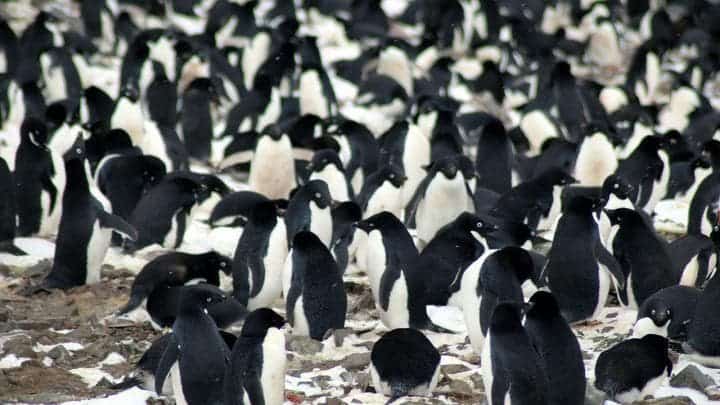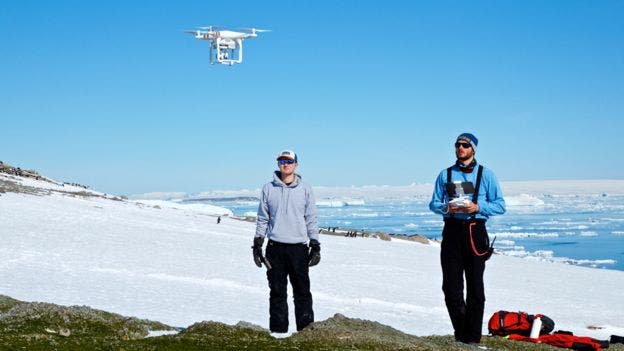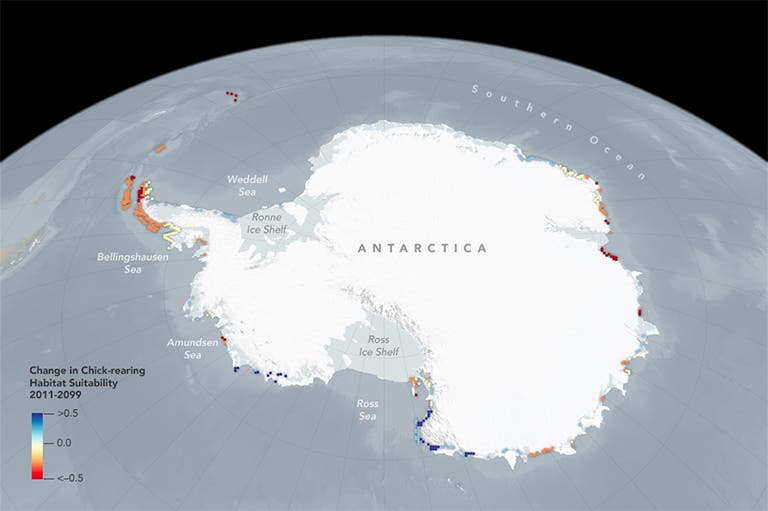During the past years, the total number of Adélie Penguins has been steadily declining. But thanks to the advent of remote sensing technologies, researchers have found a new supercolony of more than 1,500,000 individuals.

Danger Island
The first clues came in 2014 when researchers observed large patches of guano (their poo) contrasting with the mostly white, snowy background. Heather Lynch, Associate Professor of Ecology & Evolution at Stony Brook University, and her colleague Mathew Schwaller, from NASA, were curious to see what the source of the guano was, so they contacted Stephanie Jenouvrier, a seabird ecologist at WHOI, Mike Polito at LSU and Tom Hart at Oxford University. Together, they started planning an expedition, but there was a problem: their destination was Danger Islands.
The Danger Islands were discovered on 28 December 1842 by a British explorer called James Clark Ross, who named them thusly due to the heavy fragments of ice concealed which “guard” the island. Even during the summer, the islands are extremely dangerous and difficult to explore. But, since the Landsat satellites don’t have a high enough resolution to properly describe the colony, they needed to get closer.

So in December 2015, they finally managed to get on ground and start the count. To get a clear image of the colony and to avoid disturbing the birds, they used drones which flew above the penguins and took detailed photos.
“The drone lets you fly in a grid over the island, taking pictures once per second. You can then stitch them together into a huge collage that shows the entire landmass in 2D and 3D,” says co-PI Hanumant Singh, Professor of Mechanical and Industrial Engineering at Northeastern University, who developed the drone’s imaging and navigation system.

Large and healthy
Researchers found that theDanger Islands host a whopping 751,527 pairs of Adélie penguins, including the third and fourth largest colonies in the world. But here’s the thing: not only have they found an incredible number of penguins, but these penguins seem unfazed by the woes of other populations.
“Not only do the Danger Islands hold the largest population of Adélie penguins on the Antarctic Peninsula, they also appear to have not suffered the population declines found along the western side of Antarctic Peninsula that are associated with recent climate change,” study co-author Michael Polito, an assistant professor at Louisiana State University, said in a statement.
The Adélie penguins, which measure 46 to 71 cm (18 to 28 in) in height and 3.6 to 6 kg (7.9 to 13.2 lb) in weight, have been under significant pressure from warming temperatures and diminishing ice ranges. A 2016 study found that a third of current Adélie colonies may be in decline by 2060, and approximately 60 percent of the present population might be dwindling by 2099. It’s hard to say exactly what is causing their decline, but it’s likely a sum of factors related to temperature shifts.

“It’s hard to know the causes. Clearly, climate change and reduction in ice and krill play a part, but a decline in sea-ice also allows in shipping – fisheries in particular – which may exacerbate the problem,” adds Jenouvrier.
“In the past we’ve looked at this on the West Antarctic Peninsula versus places like Elephant Island (further to the north). Finally getting into the Danger Islands and counting the penguins shows how robust populations are where the ice is intact.”
Furthermore, having an accurate count allows researchers to better understand the situation and challenges of the species, and will improve the accuracy of future countings. But it also adds new questions which researchers hope to answer in the future.
“The population of Adélies on the east side of the Antarctic Peninsula is different from what we see on the west side, for example. We want to understand why. Is it linked to the extended sea ice condition over there? Food availability? That’s something we don’t know,” she says.
Journal Reference: Alex Borowicz et al. ‘Multi-modal survey of Adélie penguin mega-colonies reveals the Danger Islands as a seabird hotspot’. doi:10.1038/s41598-018-22313-w


